Urban Tree Climbing
In Amerika is
boomklimmen een georganiseerde sport geworden. In Nederland word
je nog raar aangekeken als je het doet, maar als je het eenmaal
geprobeerd hebt wil je het steeds opnieuw doen. En niemand die je
ziet als boven zit. In de zomer is het heerlijk koel en in de
winter heb je een uniek uitzicht. Helaas vinden
"gewone" rots klimmers het idee te kinderachtig of
juist te gevaarlijk. Ik heb dus weinig partners waar ik het mee
kan doen en moet daarom vaak soleren.
Inspiration
Climbing a tree is different from climbing a rock
end even more different from the climbing-hall. It is a different
experience to climb a living object that moves in the wind. The
canopy has a calm, meditative atmosphere and invites you to stay
for a while. I'm not that romantic, but I can understand that
some people talk to trees:
The more I look at the tree, the more I
see the tree: Its space and location, its volume and
structure, its engineering and balance. More than that, I
see the uniqueness of each single tree, and beyond that
still I see it as a great emblem of life. A potent
vibrant tower, a whirling prayer wheel of natural energy.
(David Nash, artist)
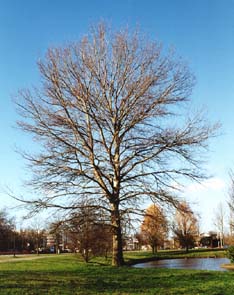 |
My favorite tree
This tree is near my house and it was
the first tree I ever climbed. It is a symmetric and
healthy poplar tree 25m high and I dare to climb
18m high (6 floors). I'm not (so much)
afraid when I'm high among the branches. The view
is wonderful. I had to get used to the wind and the
swinging branches. I found out that it get's scary at
wind speeds above 5 beaufort.
I don't dare to climb into the highest branches.
Theory says that 12 cm branches are usually enough to
hold your weight. But my 80kg were easily held by 7cm oak
branches. It depends on the kind of tree you climb.
|
| The view |
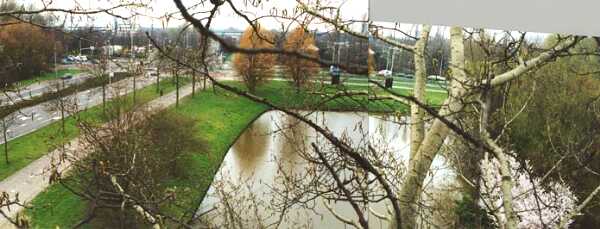 |
More people have stood on top of Mt Everest than on top of
this tree. Not many others have seen this view. Notice the cherry
tree in bloom (lower right corner). The view is very much
dependent on the seaon:
| Winter view |
Summer view |
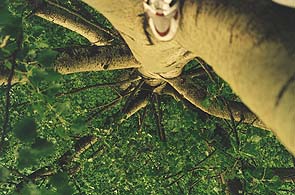 |
 |
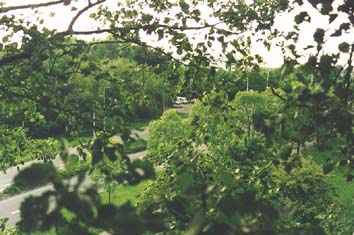 |
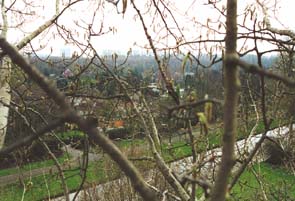 |
| You can see that the summertime is not a good time to
photograph the view from a tree. Therefore I had to come
back in early spring. But the atmosphere up there is
nice, quiet and thought-inspiring. And you're completely
invisible. |
In early spring the view is magnificient. And even
though everyone should be able to see you, no one cares
to look up. So you're still invisible. It is colder, but
the tree sways less in the wind. Therefore I dared to
climb higher. |
Nice experiences
Last summer I found a few spare moments to climb new species
of trees. I tried the 30 year old oak trees along the railway
near Terbregge. It was fun feeling the tree sway in the wind. I
looked down on the roofs of the trains driving on the embankment
but I was sure that no one could see me. I came home covered with
green algae from the bark of the tree. I climbed another small
oak tree with my son. The branches are thin but very solid.
During a spare moment I climbed one of the plane trees at the
back of my apartment building. Very carefully I chose one where
the neighbours couldn't see me. At 3d floor height (10m) I lay
down on one of the thick branches and watched the canopy. I saw
our local magpie visiting it's nest. It was very peaceful, now I
know how a tiger lying on a branch must feel (look at a random
wildlife report in the National Geographic and you will see this
posture). This time some passers'by saw me, and thought I must be
mad ...
Plans for future projects
I'm somewhat limited in my possibilities. Conventional (rock)
climbers are usually not attracted to tree-climbing. Some find it
too scary, others find it too easy or childish. So it's difficult
to find climbing partners. So all of the pictures on this page
were made while soloing in the tree. But my wife (wisely) insists
that I shouldn't go tree-climbing alone. But if I can solve this
dilemma I would like to:
- climb the monumental plane-trees between the Central
Station and the Nationale Nederlanden. This should give a
unique view of the city center.
- explore more species of trees in the Kralingse Bos. I've
already spotted and photographed several sturdy
candidates - oak, beech, poplar, ash, pine and spruce.
- climb the (smallish) plane trees in the busy center of
Rotterdam, for example in front of the Bijenkorf or the
Post Office. This shouldn't give a spectacular view, but
it should attract a lot of attention. And we would know -
by experiment - if tree-climbing is legal or not.
Techniques for
getting up 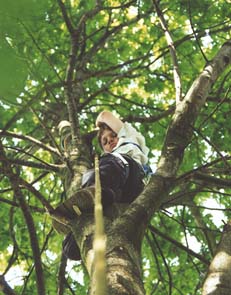
|
If the lowest branches are reachable
you can simply climb into the tree as if you were
climbing a ladder. If you go any higher than 3m you
should use some kind of belay and a climbing harness. A
helmet would also be useful.
- Here you see my son in an easily
climable tree. He is secured by a top-rope. The
anchor is a screw-carabiner hanging from a sling
around the trunk. Never use just a sling as a
top-anchor, it could be burnt by the rope.
If the lowest branches are unreachable
you will have to use a ladder or an arborist rope to
reach the first branch. You can see a demo of this
technique here. I've used it often to get on top of
billboards:
From there you can choose from several
techniques to continue. I prefer the "secured
free-climbing" technique:
- Loop the first sling (runner)
around the trunk or a sturdy branch.
- Clip the first cowtail with a
carabiner into both ends of the sling. Now you're
secured.
- Climb 1m higher.
- Loop the second sling around the
trunk or a sturdy branch.
- Clip the second cowtail with a
carabiner into the sling.
- Unclip the first (lower) carabiner
and untie the sling. You're still secured.
- Repeat as often as necessary.
I use a special cow-tail setup with a
shock-absorber. It's the "Zyper" made by Petzl.
I'm very satisfied with this tool.
The book "Mountaineering freedom
of the hills" says the following about trees as
top-rope / rappel anchors. It's also relevant to tree
climbing:
- The best natural anchor is a
living, good-sized, well-rooted tree.
- The trunk or branch should be at
least 10cm (4 inches) thick.
- You can throw the rope around an
unquestionably stout tree branch rather than low
on the trunk. This reduces the abrasion on the
rope. But it puts more leverage on the tree and
increases the danger that it will be pulled out.
- Be careful using trees in very
cold weather. They can become brittle.
|
Techniques for getting down
Officially the best way to get down is the same
way that I showed in the "demonstration". The Blake's
hitch can be used for rappeling. So you use the same technique
but in reverse. Descend slowly, or the knot will burn the rope.
But because I prefer "secured free
climbing" to get up, I use the classic rappel technique to
get down:
- Secure yourself to the tree with a runner
or short piece of rope, anything so that you are tied in.
- Untie your tree-climbing rope and double
it around the tree trunk or over a branch. Let the two
ends meet somewhere on the ground.
- If the two ends don't reach the ground -
or if you are not sure - then you MUST tie knots in BOTH
ends of the rope, to prevent rappeling past one of the
strands! This is a deadly mistake.
- Attach your figure 8 around BOTH strands
of your rope.
- Then descend the double ropes by
rappelling down with a "figure 8".
- Once down just pull your rope down.
Is it legal ?
I don't really know. I think that technically
speaking it is illegal, but that you won't be fined. I suspect
you will be chased away by the policeman or the forester. The
issue was discussed on the Treeclimbing forum:
- Question:
- What's the best way to avoid involvement with the law
when treeclimbing? (Or get out of a legal bind if you
find yourself in one.) Are you better off just sticking
to climbing in secluded areas of public lands (national
parks/forests, etc.)? Or maybe explain to the officer
that you've left your arborist's chainsaw at the house?
Or would the direct approach worth a shot (like asking
local law enforcement about any constraints)?
- Answer:
- This is what I have had sucess with: I draw their
attention to the quality of the gear that I am using and
ask/tell them that I am a serious arborist doing a site
survey and its hard work. (appeal to their work ethics)
- That this tree that I am "measuring" for enrty
into the record book of trees. (Be sure to have a ruler
with you)
- It is a perfect specimen of Platanus americanus. (Latin
names sound like your real smart and hope that they don't
know a sycamore from shinola)
- Kind of ask/tell them that this tree is in the public
domain isn't it? (and aren't we lucky to have be alive
while it is in it's glory)
- The many officers that I have talked to agree that they
can't tell you not to go up but they can tell you to come
down if they feel it is a hazard to others. (appeal to
their sense of duty and agree that you can do no harm to
the tree, yourself or others; shoot they drag injured
climbers off of rockcliffs all the time)
- Assure them that you do this all the time and are well
qualified; flash the TCI membership card. (sometimes I
wish it look more like a badge)
- If all else fails ask them if they want to give it a try.
(most officers that you'll meet out where trees grow will
not be the desk jockeys, chain gang foremans or highway
patrol types that will get on your case; one city
forester told me that they only time he climbs is to cut
the bastards down)
- Just be believable and assure them that you know of no
laws forbiding climbing trees. (if you ask them they may
even know of other bigger trees)
More information on the treeclimbing
website
For this page I've used some information from the
treeclimbing.com website. Very inspiring to read. Basic
information can be found in the climbing-technique chapter. And
if you have any questions or problems you can visit the message
board. Even basic beginner's questions are handled in a patient
and professional manner. These (and many other) links are shown
on my links-page.
Books
This book tells you all you want to know. There's a second
printing available. VERY GOOD VALUE FOR MONEY
- Jeff Jepson
The Tree Climber's Companion
Beaver Tree Publishing
HC 1 Box 546
Longville, MN 56655
- Example:
- "Inspect each tree completely from the ground before
you climb for potential hazards. Examine all sides of the
tree from the roots to the branches. The foliage will
often obstruct the view of the hazards hidden within the
canopy. Use binoculars for viewing if necessary. Survey
the climbing site. Be watchful for poisonous plants,
wet/muddy areas, extreme slopes and immovable objects
such as lawn ornaments and flower beds."
Reactions to this page
After I posted this page on the treeclimbing
message board I received several comments and new links. The
comments are shown here - I feel very encouraged to continue
treeclimbing. The new links are included on my links-page:
- Hallo Petr, ik ben nooit een boeken lezer geweest maar ik
ben wel altijd buiten geweest. Ik heb dat boekje van
"The tree climbers companion" van Jeff Jepson
al helemaal doorgelezen en ook een heleboel van geleerd.
Ook heb ik een boekje van het ipc groene ruimte
"werken in de bomen" hierin staan ook een
heleboel belangrijke dingen alleen is dat meer voor het
echte werken in bomen. bijvoorbeeld als boomverzorger. Ik
heb ook even op internet gezocht naar dat andere boek
van: "Sicherheit und Risiko auf Fels und Eis"
van Pit Schubert. alleen kreeg ik het gevoel dat het meer
voor het klimmen in bergen is. (of is mijn duits nog
slechter dan ik denk dat het is?)
Ja ik heb van het boom-klimkampioenschappen gehoord en ik
wil als ik optijd ben volgend jaar gaan kijken zul je net
zien dat je er achteraf achter komt dat het is geweest.
Even een paar vraagjes met wat voor touw en hoelang is je
touw waarmee je klimt. Ik moet binnenkort namelijk een
nieuw touw hebben geloof ik. Nu gebruik ik een octoply 20
meter touw. Ik vind het een heel fijn touw omdat het niet
heel gemakkelijk glijdt dus sta je ook niet direct op de
grond als je per ongeluk iets te hard in je pruisische
knoop knijpt. Alleen vind ik 20 meter een beetje kort dus
denk ik in de richting van 30 tot 40 meter.
Nou ik spreek je denk ik nog wel eens. Groeten, Jildert
- Michael Oxman asks: I was wondering what polyester
arborist rope is colored black?
Well, I hope it's
polyester and that it's arborist rope.
It's 14 mm kernmantle with a black sheath and a white
kernel. It has proven to be quite resistant to wear and
very static (I mean
non-stretch). The only time I hurt it (a bit) was when I
pulled someone up over a stone edge.
I bought 20m of it in Rotterdam's specialist rope store.
I have good experience with their security consciousness.
They even refused to sell me the cheap rope I wanted (for
building a rope bridge) after I told them what I needed
it for ... I got it off the roll, so I don't really know
what I got, but it's the store where every climber and
sailor goes. They've been selling all kinds of rope for
over 50 years, so I trust my life in their hands ...
- Hallo Petr, Leuke site! Prachtige foto's vanuit de
populier. Een leuk idee om de camera mee naar boven te
nemen. Weinig boomklimmers in Nederland. Een paar
bosbouwbedrijven in mijn omgeving doen soms wat klimwerk.
Succes! Dick Knol, Colmschate.
- Hello Petr - Congratulations with your new climbing site.
Concerning permission to climb in trees, why dont you
simply ask the owner of the woods - Private persons, the
state, companies, organisations or whoever it is. It
works fine here in Denmark, I myself have permission to
climb in 5 different woods or forests - and that enough
for mee. And then you donīt create any worries for
the owners - of course they are interested in the trees
not being damaged, because trees are an investment
on looooooong time, actually several generations.
Greetings from Denmark Anders.
- Use common sense. Just so you know, I climb everything. I
have to climb at work and wind is very dangerous. -
brockamy
- Hello Petr Kazil. A nice site, good pictures. Maybe you
should try a softer background. The dark background is
good to make the front visible, but your stories invites
people into a room of nature, understanding and deep
thinking, so the courlor might be softer? Well, thats an
idea. Good climbs and take care. By the way, dont climb
alone! You`ll have to bring your wife. I gave my wife a
birthdaypresent when she became 40. I invited her for
coffee,...up in Northeuropes bigget Nordmannsgran ( abies
normanniana). Its a big tree, well, 38 meters tall
and is groving on the top of a hill in the forrest by a
lake. We went to the very top where we had
coffee,chokolate and a little Bitter. Its like a nest up
there. She was terrified, but very brave and it was a
beautiful day. I`ve been working as a treesurgeon for 22
years, and married to her for 20, but this was the
very first time she tried to do what I have been doing
every day for such a long time. Without a chainsaw, heavy
wood and dust, but with talk, sun and birds. A good day.
Do that! Regards - Allan Bo Jensen - Denmark
- My answer: As you can see I changed the
background color.
- Hi, I was very glad to see your site. We have a
treeclimbing School in Japan. Tree Climbing is
great. Glad to know we have more tree-friends all
over the world. Your JOHN.
- Peter, Loved the site and your links. Picked up your site
from TCI.com. I noticed when you are climbing the
advertisement sign the is no friction saver on the rope
at the ladder. Does it burn rope at this juncture? Hope
you keep us updated on whats happening over your way.
Matt Mitchell
- My answer: Fortunately not. I'm aware of this
risk, and I checked the ladder beforehand. The
rungs are smooth, round steel bars. So the rope
is not damaged. On the contrary ... I found
several traces of yellow paint on my rope, where
it had scraped the ladder. I use 14mm polyester
rope. I have only used a rope protector when we
were climbing a 12th century castle ruin and when
I threw the rope over a brick wall.
- I loved your web page! I think more people will be
captured by the idea of climbing as more people like you
help by exposing us to the possibilities. And speaking of
possibilities, you might suggest to your wife that she
would be the perfect parnter to climb with you! Now
there's a romantic outting for two! Thanks again for the
time and artistry you've invested. Ruth.
- I like your site. The pictures are great! I liked your
comment on the fact that more people have stood on Mt.
Everest than at the top of that tree. Hope you can find
someone to share your trees with. It's more fun with
company. Bill
Back to: Urban Climbing, Urban Adventure Home
Đ 2001 Petr Kazil - 8 January 2001 - Have you climbed trees
in your childhood ? How high did you go ? Mail me at (obfuscated) kazil a.t euronet d.o.t nl






